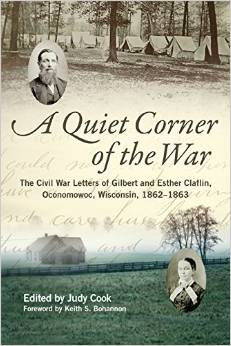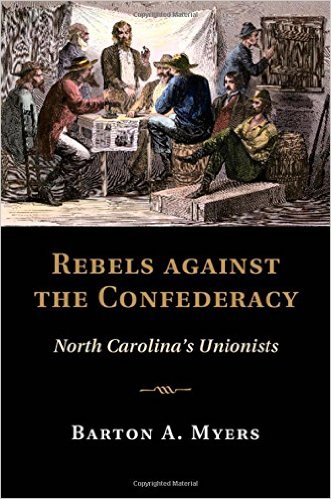A Quiet Corner of the War: The Civil War Letters of Gilbert and Esther Claflin, Oconomowoc, Wisconsin, 1862-1863 by Gilbert Claflin and Esther Claflin and edited by Judy Cook. University of Wisconsin Press, 2014. Cloth, IBSN: 978-0299294809. $26.95.
 Recent scholarship on the Civil War has brought into clearer focus the interconnections between homefront and warfront. Judy Cook’s A Quiet Corner of the War makes an important contribution to this trend by revealing the interplay between Gilbert and Esther Claflin, a married Wisconsin couple who were separated when Gilbert was conscripted into the Union army. The Claflins’ letters—and Cook’s careful and thorough annotations of them—highlight the idea that what happened on the battlefield was only a small part of the Civil War story. Their letters reveal a close familial relationship and a mutual dependence upon each other, as well as a dedication to the Union effort and emancipation. Their specific references to a wide range of people and events allow readers to get a detailed glimpse at both the Civil War homefront and warfront.
Recent scholarship on the Civil War has brought into clearer focus the interconnections between homefront and warfront. Judy Cook’s A Quiet Corner of the War makes an important contribution to this trend by revealing the interplay between Gilbert and Esther Claflin, a married Wisconsin couple who were separated when Gilbert was conscripted into the Union army. The Claflins’ letters—and Cook’s careful and thorough annotations of them—highlight the idea that what happened on the battlefield was only a small part of the Civil War story. Their letters reveal a close familial relationship and a mutual dependence upon each other, as well as a dedication to the Union effort and emancipation. Their specific references to a wide range of people and events allow readers to get a detailed glimpse at both the Civil War homefront and warfront.
Unlike many of his countrymen, abolitionist Gilbert Claflin did not rush out to join the Union Army at the start of the war. Instead, he was drafted in November 1862 and sent to Milwaukee to begin his nine-month term of service. His regiment, the Thirty-Fourth Wisconsin, was filled with many men who had been similarly conscripted into service and who opposed the draft. As a result, many of these men deserted, a subject that Gilbert frequently discussed in his letters home. Gilbert, too, considered his options for avoiding service. In many of their early exchanges, he and Esther debated whether or not he should hire a substitute to take his place in the regiment. In the end, despite his wife’s desire to have him safe at home, Gilbert decided against it—stating that even if he paid for a substitute, he might get called for service in a subsequent draft. Furthermore, once he got used to the monotony of camp routines, Gilbert found that he enjoyed the life of a soldier. He regularly sent home detailed descriptions of his days and thoughts to his wife and their two sons, Elton and Price. His faithful letter writing helped him to keep track of his days: “did I not keep a note of daily occurrence, I should hardly keep the day of the week” (139). Despite this small complaint, Gilbert found many things he liked in the soldier’s life. He enjoyed picket duty, as well as his time spent working in the regiment’s hospital. In addition, he spent much of his time enlisting African American men for the Union army. In May, he proudly reported to Esther that, “there has been between 4 & 5 hundred Negroes enlisted here” (150).
The Claflins’ exchange of letters reveals as much about life on the homefront for Esther and the children as it does about Gilbert’s camp life. In her letters, Esther candidly revealed her concerns about her husband and the war, as well as the details of her daily life. She listed the crops they harvested at home, what their sons planted in the fields, and the people she saw at church. Out of necessity, Esther took part in their wartime farming work and discovered (to her surprise) that she liked it. Esther also worried about disease in their community, especially smallpox, and apologized that “there was nothing cheerful to write about… For we are being cursed with war and pestilence”(151). She knew that her letters were both an outlet for her thoughts as well as a boost to her husband’s morale while he was far from home.
Much of their correspondence focuses on the war itself. In particular, the reader gets a unique look at the perspectives of abolitionists during wartime. When Gilbert realized that Esther “seem[ed] very discouraged about the war,” he affirmed his confidence in Union success and the necessity for it. As an abolitionist, he “never felt more encouraged” and he applauded the United States government because it “places the musket… In the hands of the slave” (157). For her part, Esther supported what Gilbert was doing, although she did not see her part in the war as being as glorious as his. Despite her husband’s confidence in her work on the homefront, Esther confessed, “Gilbert, I ain’t much of a heroine. I feel all the time as though I wanted somebody else to take the responsibility. Selfish, ain’t it?” (161). Her self-doubt and sometime resentment of the tasks left to her reflects the attitudes of many of her countrywomen. Women in both the Union and Confederacy often expressed their wish that the men would return and take over the responsibilities of the household. Despite evidence to the contrary, Esther emphasized her belief that she was not up to the task of running a farm and told Gilbert that he was “needed here very much. The boys are running wild, and the cattle and colts are getting very troublesome” (211).
In addition to the letters between family members, editor Judy Cook has included five useful appendices. These appendices list the names of family and neighbors and explain their relationships to the Claflins; describe the Wisconsin towns of Summit and Oconomowoc, where the Claflin family lived; lay out the details of military recruitment, conscription, terms of service, as well as give information on those who served in the military with Gilbert. The final appendix explains how Cook transcribed and edited the letters.
This volume is a welcome addition to the growing literature on families and households in the Civil War. Twenty-first century scholars are lucky that Gilbert and Esther Claflin chronicled the war from their perspectives with such attention to detail, and that Judy Cook took such careful attention to highlight their experiences.
Lisa Tendrich Frank is the author of The Civilian War: Confederate Women and Union Soldiers During Sherman’s March (2015).
